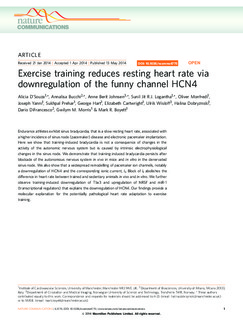| dc.contributor.author | D'Sousa, Alicia | |
| dc.contributor.author | Bucchi, Annalisa | |
| dc.contributor.author | Johnsen, Anne Berit | |
| dc.contributor.author | Logantha, Sunil | |
| dc.contributor.author | Monfredi, Oliver | |
| dc.contributor.author | Yanni, Joseph | |
| dc.contributor.author | Prehar, Sukhal | |
| dc.contributor.author | Hart, George | |
| dc.contributor.author | Cartwright, Elisabeth | |
| dc.contributor.author | Wisløff, Ulrik | |
| dc.contributor.author | Dobryznski, Halina | |
| dc.contributor.author | DiFrancesco, Dario | |
| dc.contributor.author | Morris, Gwilym | |
| dc.contributor.author | Boyett, Mark | |
| dc.date.accessioned | 2015-09-29T12:06:18Z | |
| dc.date.accessioned | 2015-10-23T11:33:05Z | |
| dc.date.available | 2015-09-29T12:06:18Z | |
| dc.date.available | 2015-10-23T11:33:05Z | |
| dc.date.issued | 2014 | |
| dc.identifier.citation | Nature Communications 2014, 5 | nb_NO |
| dc.identifier.issn | 2041-1723 | |
| dc.identifier.uri | http://hdl.handle.net/11250/2357890 | |
| dc.description.abstract | Endurance athletes exhibit sinus bradycardia, that is a slow resting heart rate, associated with
a higher incidence of sinus node (pacemaker) disease and electronic pacemaker implantation.
Here we show that training-induced bradycardia is not a consequence of changes in the
activity of the autonomic nervous system but is caused by intrinsic electrophysiological
changes in the sinus node. We demonstrate that training-induced bradycardia persists after
blockade of the autonomous nervous system in vivo in mice and in vitro in the denervated
sinus node. We also show that a widespread remodelling of pacemaker ion channels, notably
a downregulation of HCN4 and the corresponding ionic current, If. Block of If abolishes the
difference in heart rate between trained and sedentary animals in vivo and in vitro. We further
observe training-induced downregulation of Tbx3 and upregulation of NRSF and miR-1
(transcriptional regulators) that explains the downregulation of HCN4. Our findings provide a
molecular explanation for the potentially pathological heart rate adaptation to exercise
training. | nb_NO |
| dc.language.iso | eng | nb_NO |
| dc.publisher | Nature Publishing Group | nb_NO |
| dc.title | Exercise training reduces resting heart rate via downregulation of the funny channel HCN4 | nb_NO |
| dc.type | Journal article | nb_NO |
| dc.type | Peer reviewed | en_GB |
| dc.date.updated | 2015-09-29T12:06:18Z | |
| dc.source.volume | 5 | nb_NO |
| dc.source.journal | Nature Communications | nb_NO |
| dc.identifier.doi | 10.1038/ncomms4775 | |
| dc.identifier.cristin | 1153759 | |
| dc.description.localcode | This work is licensed under a Creative Commons Attribution 3.0 Unported License. The images or other third party material in this article are included in the article’s Creative Commons license, unless indicated otherwise in the credit line; if the material is not included under the Creative Commons license, users will need to obtain permission from the license holder to reproduce the material. To view a copy of this license, visit http://creativecommons.org/licenses/by/3.0/ | nb_NO |
